Leeds United hosted Hull City on Tuesday at Elland Road in an intense fixture that saw Leeds go to the top of the EFL Championship table. After a hard fought first half that ended 0-0, Hull City displayed a brilliant tactical performance against the home side conceding in the second half due to an unfortunate own goal and a counter-attack soon after. Grant McCann remarked,
“We thought we had scored and then 20 seconds later it was in our net at the other end.”
The three points were vital for Marcelo Bielsa’s Leeds to challenge West Brom whom they have been chasing all along. In this tactical analysis, we shall examine how these three points did not come easy with a closer look at both teams’ tactics.
Lineups
Leeds United (4-1-4-1): Kiko Casilla, Luke Ayling, Ben White, Gaetano Berardi, Stuart Dallas, Kalvin Phillips, Helder Costa, Pablo Hernandez, Mateusz Klich, Jack Harrison, Patrick Bamford,
Subs: Kamil Miazek, Barry Douglas, Robbie Gotts, Pascal Strujik, Ezgjan Alioski, Jack Clarke, Edward Nketiah
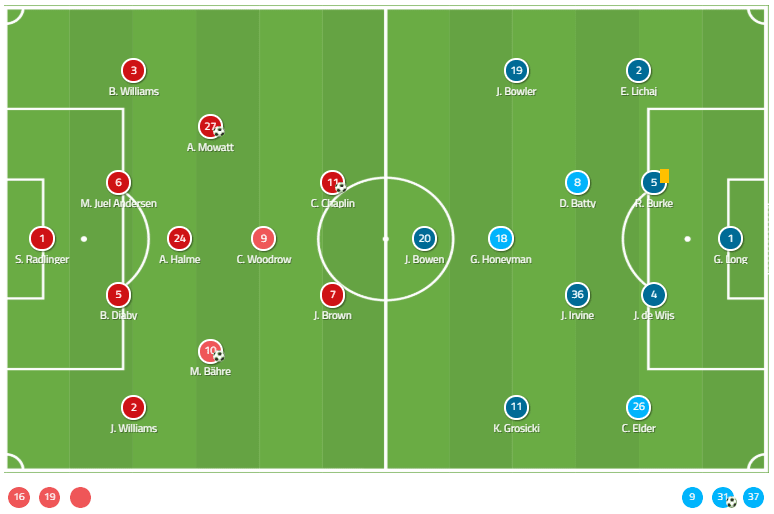
Hull City (4-2-3-1): George Long, Callum Elder, Jordy de Wijs, Reece Burke, Eric Lichaj, Kamil Grosicki, Leo da Silva Lopez, Daniel Batty, Jarrod Bowen, Jackson Irvine, Tom Eaves
Subs: Matt Ingram, Matthew Pennington, Stephen Kingsley, Ryan Tafazolli, Josh Bowler, George Honeyman, Keane Lewis-Potter
Leeds attacking organisation
We expected Leeds to come out sticking to their principles of play constantly practised by Bielsa every week: High pressure to win the ball, plenty of rotations, getting numbers forward (or back) in transitions and creation of chances by all the forward players. The defensive due of Berardi and White looked to buildup confidently with the quality of Phillips as the solo pivot who has shown some outstanding performances this season. The fullbacks were given a lot of mobility to start overlapping or underlapping runs to create overloads on the wings and the inner corridors in the attack.
Klich played as a box-to-box midfielder providing the link for Phillips to play the short pass while playing out from the back or filling in the hole if Phillips was being man-marked. Hernadez, who has been an important addition after his long injury break, was played in an offensive role to work on the second balls from Bamford and support the striker and the wingers if needed. Harrison would continue to provide the qualitative superiority on the left-wing, having the highest number of dribbles in the league and Costa would provide the threat from the right-wing.
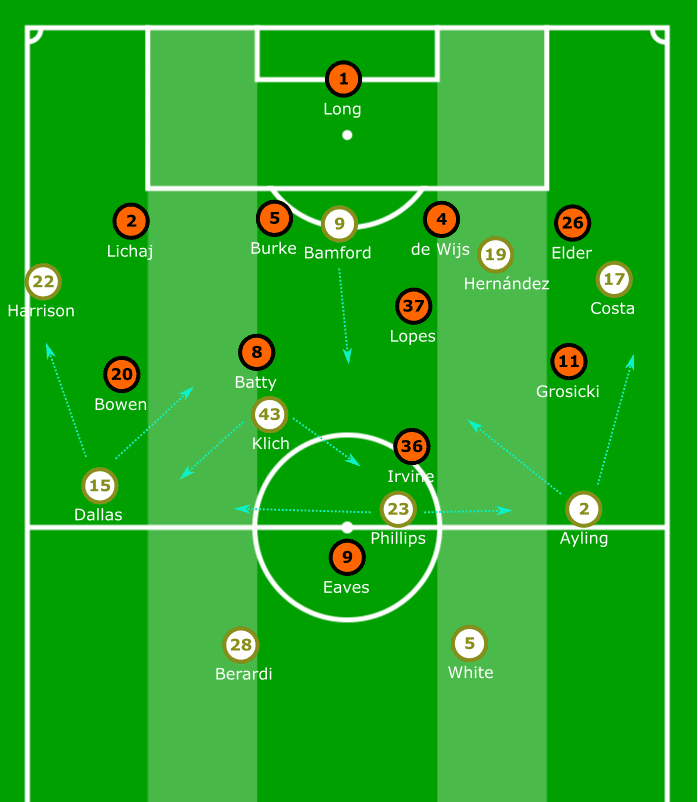
It was important for the home side to have a successful buildup to ensure the momentum of the rotations was carried forward into the final third. The objective was to find the right pockets of spaces in the middle of the pitch for the intelligent players like Klich, Hernandez and Phillips to exploit. But Hull City were successfully able to keep them quiet for the entire first half neutralize Leeds’ attacking organisation. How did they manage this? We shall look closely in an analysis of the visitors.
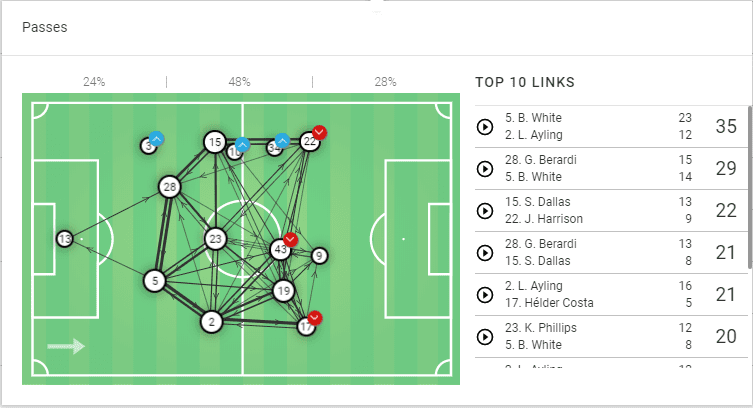
Hull City defensive organisation
The visitors sat in a 4-2-3-1 block engaging in a mid-press to avoid Leeds having a lot of space to exploit through the midfield. They were comfortable with White and Berardi having the ball which explains why the duo had a lot of possession in their own half. The priority was to control the centre, limiting the passes to Phillips in particular. This becomes clearer if we take a look at Leeds’ heatmap. We have layered Hull City’s average player positions upon this heatmap for a better reference. We see that Leeds had a lot of possession in their own half but were unable to penetrate through the middle which was effectively controlled by Irvine, Batty, and Lopes.
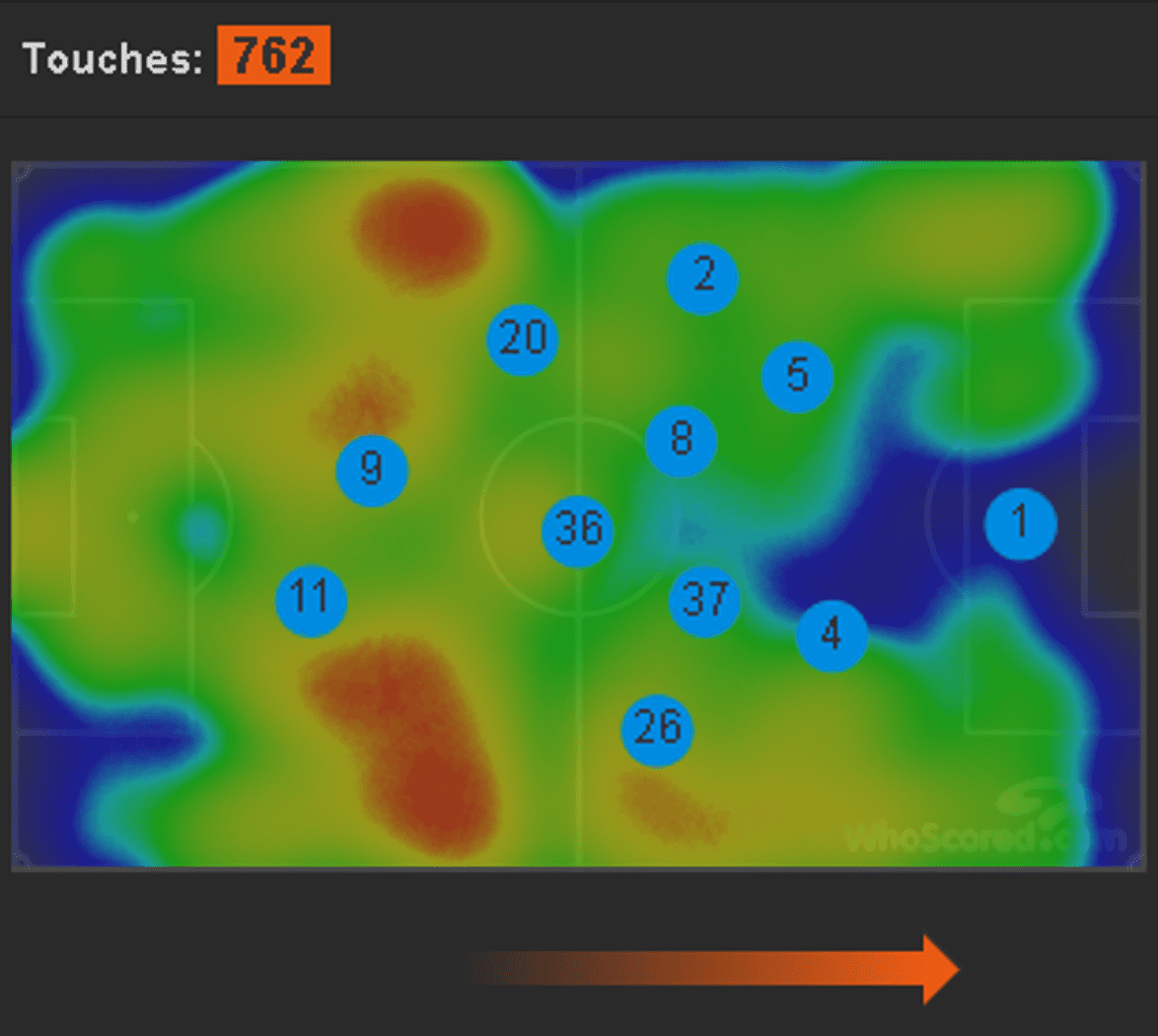
Irvine and Batty worked alongside Bowen and Grosicki while pressing, creating traps and keeping it very tight. The formation became a 4-4-1-1 with just Eaves uptop and Irvine marshalling the press. Having Irvine behind Eaves helped keep Phillips within close marking distance giving him very little space to receive the ball. Eaves always worked to keep Phillips behind in his cover shadow to close a free passing lane from the defenders. Irvine would mark him from behind. If White would come out with the ball, or Ayling would invert inside, Irvine would leave his position to press the ball carrier, while Eaves would take cover.

Bowen and Grosicki also pressed and limited the spaces in the inner corridors for the home side. Since the forwards worked so hard defensively right from the top for Hull City, the double pivot of Batty and Lopes gave them a free man to engage in the pressing should one of the forward players be beaten. This worked very effectively in dousing off the threat from Bielsa’s rotations involving the fullbacks.
In this move below, we see Dallas playing the ball wide to Harrison on the touchline and starting an underlapping run to try and beat Bowen. But we see that Harrison is closely followed by the right-back, Lichaj and Batty immediately reads the move and intercepts the second touch from Dallas. This pressing trap was like a triangle involving Batty, Bowen and Irvine from the centre giving no free spaces for Leeds to advance through the inner corridors in the midfield.
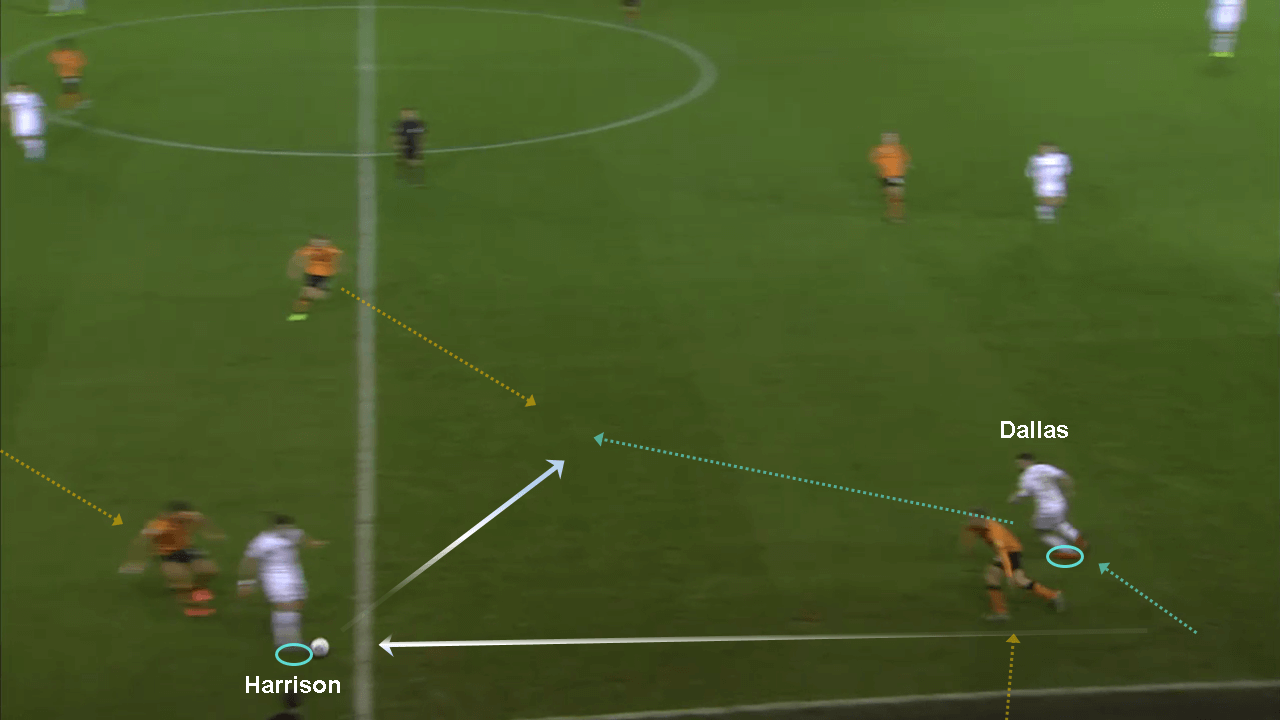
Having no real options to play out from the back, it was required for Bamford to drop deep from his position as the target man to assist in offering passing lanes.
Using Eaves as a target man in transitions
Let us now look at Hull City’s strategy on attacking transitions. After winning the ball they would seek Eaves playing as the highest man in the formation. Eaves with a massive frame of 1.91 metres and a strong physical presence held plenty of aerial advantage. He was a very effective number nine for the visitors as he was able to win aerial duels and even hold on to the ball giving time for his teammates to move forward and then lay the pass off.
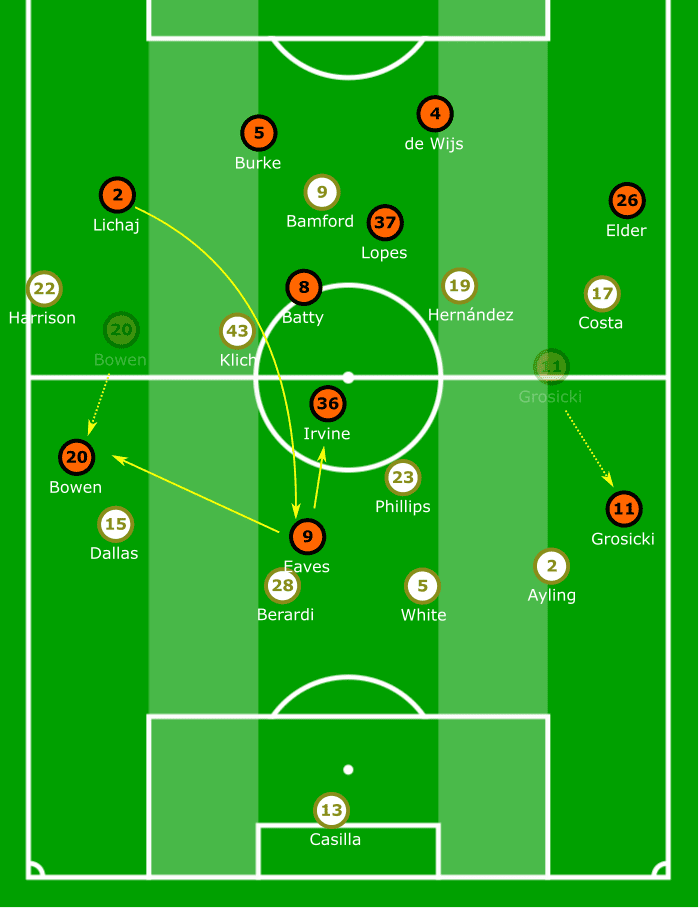
Looking at statistics, Eaves won six aerial duels out of the total 11 that Hull City won. To provide perspective, Leeds only won eight aerial duels during the game. This tells us a lot about Hull City’s strategy of playing on their strengths which was a single player’s natural ability. If we look at a plot of both teams’ aerial duels, we see that Eaves was so dominant against his defensive marker, Berardi in front of Leeds’ penalty box. Eaves also managed to force a fingertip save from Casilla from a corner with a dangerous header that would have provided the equaliser and changed the course of the game.
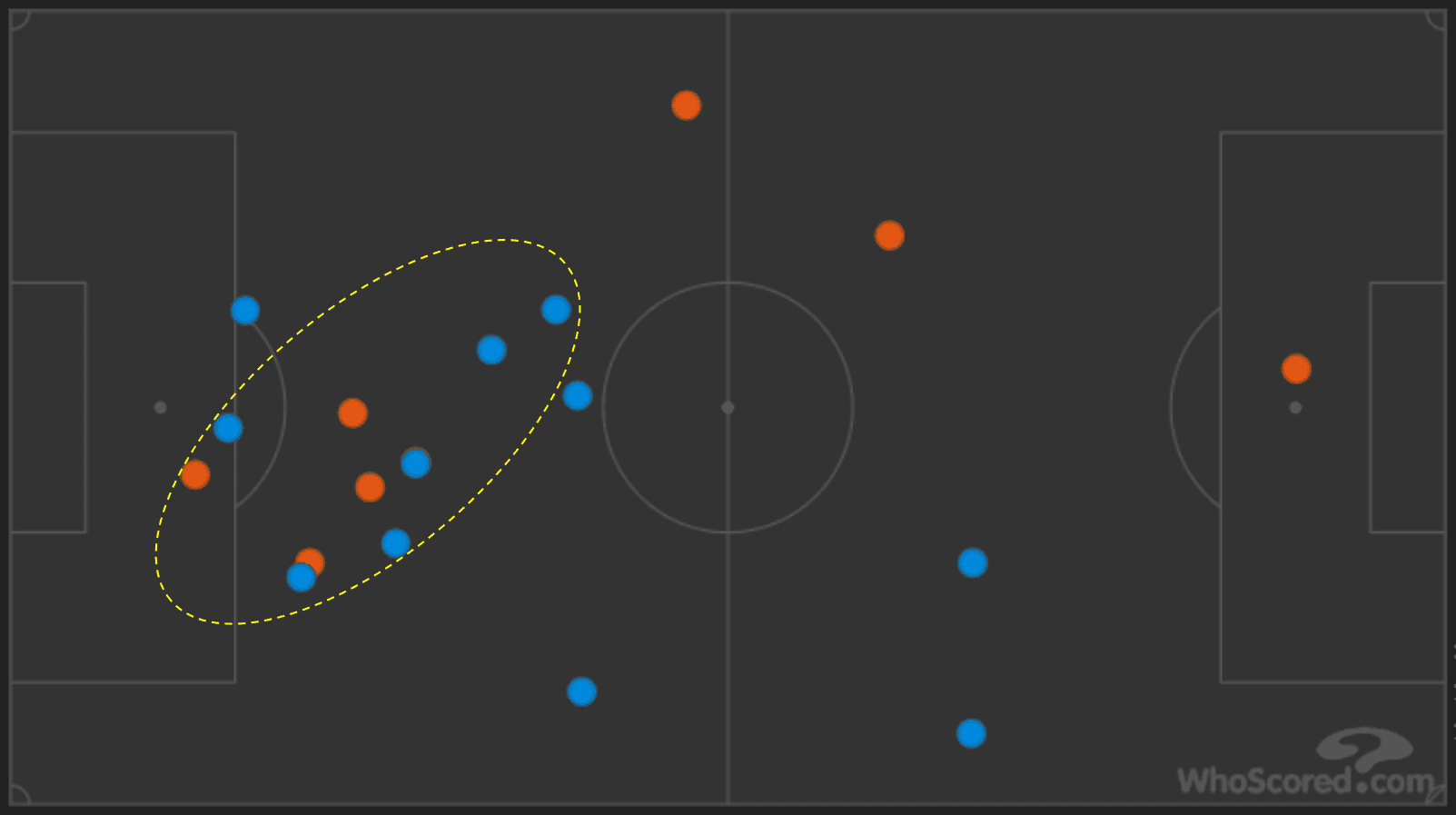
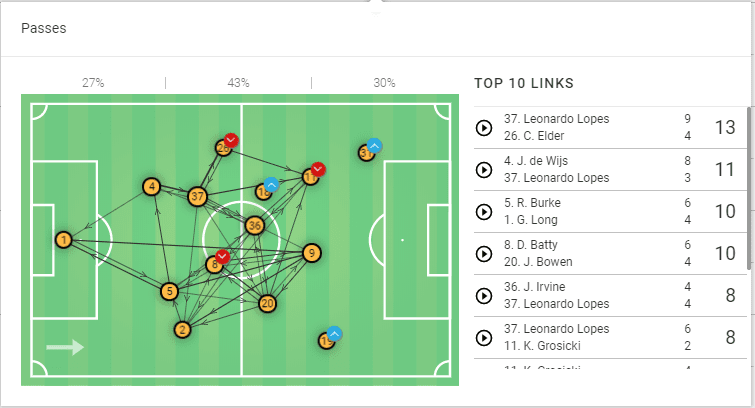
In this graphic from the game, we see how deep Eaves has dropped holding onto the ball while his teammates are advancing forward in the wide areas. He is able to pass the ball back to Lopes who can then find free men around to distribute passes. This shows how strong Eaves was in attacking transitions for Hull City.
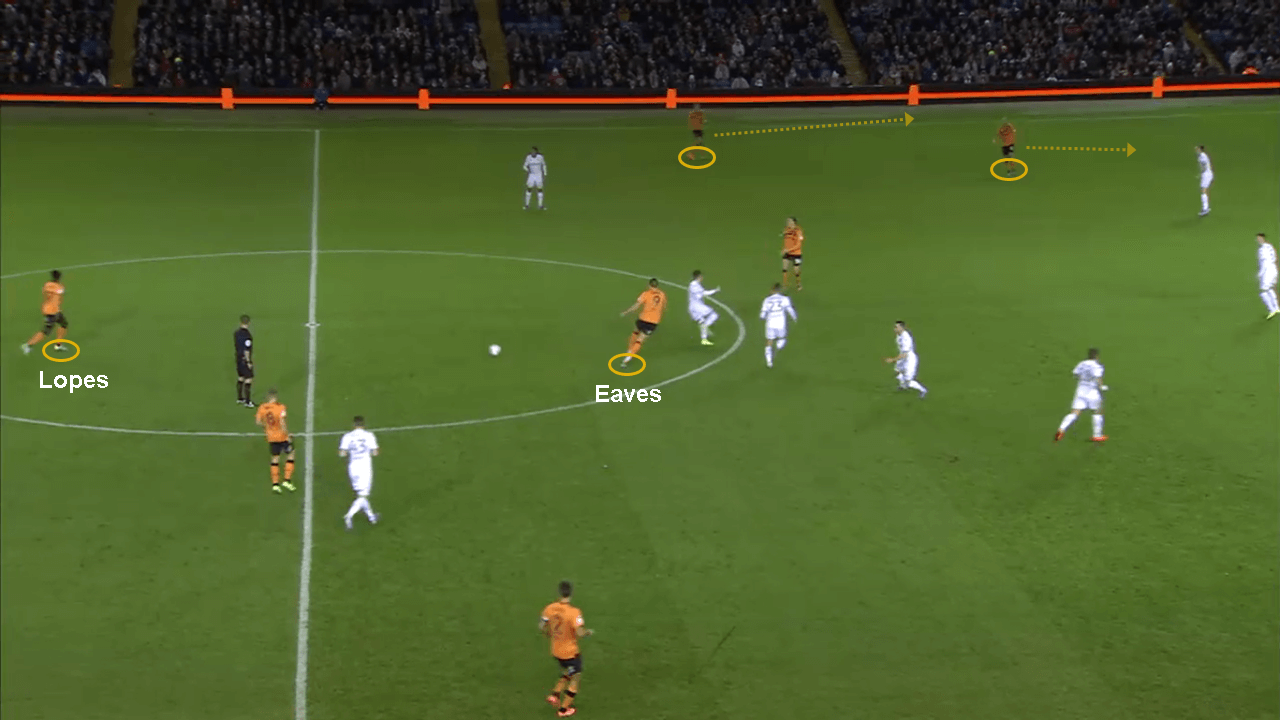
After winning the ball, Hull City were not hasty to move forward and looked to keep possession patiently, not reluctant to circulate the ball through their defence if needed. We also Hull City here having movement patterns of their own with a lot of fluidity from the forward players. We see that Batty has made a dummy run through the inside channel when Eaves has won the ball and drifted wide and deep. This gives room for Bowen, the wide winger to cut inside and find the pass back from Eaves.
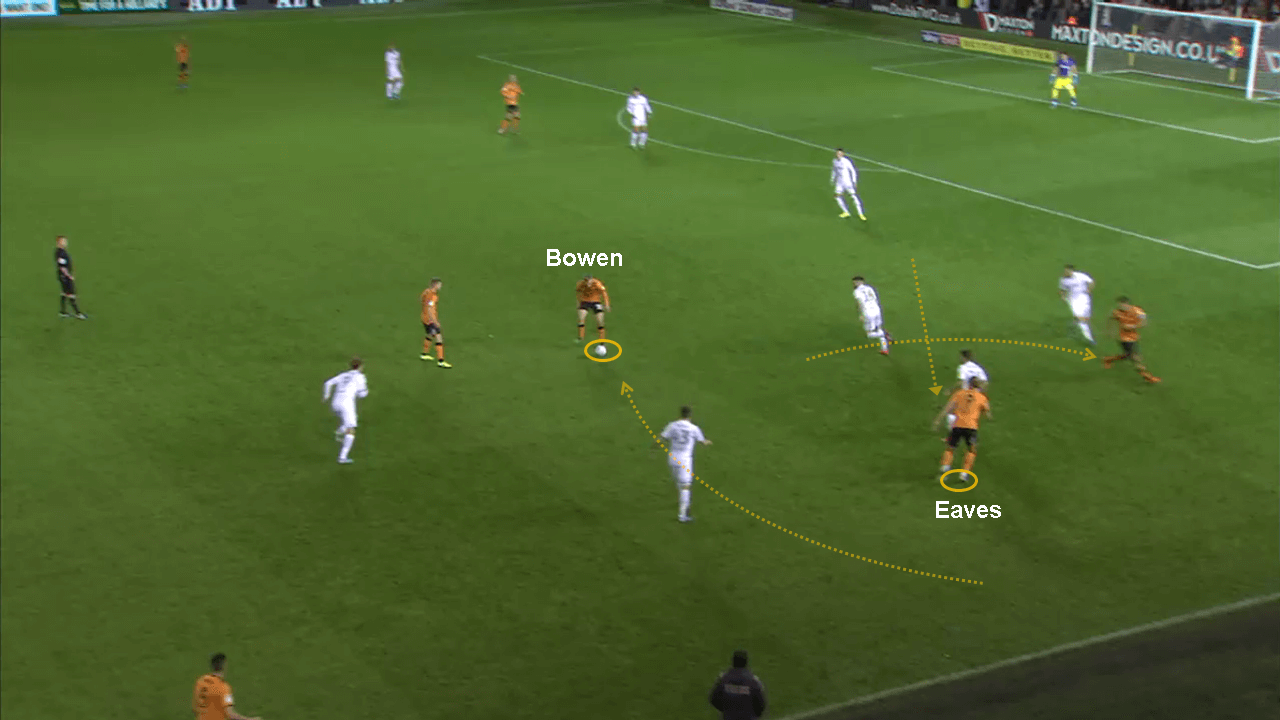
Leeds strategy to exploit width with Harrison
Hull City’s tactic to keep the shape compact through the centre and force Leeds to one side meant there would always be space on the opposite flank. Against most teams, it was Kalvin Phillips’ job to pick up the ball in a deep position from his own half and distribute a diagonal cross-field ball to the opposite flank. But we have already seen how Hull City denied the Leeds’ midfielders room in front of their defence to switch the play.
Thus, the only way that Harrison could be found as a free man was in attacking transitions for Leeds when there would be situations of numerical superiority. In 4v3 or 3v2 scenarios on the attack, the Hull City defenders would be forced to defend the line and close down the attack outside their box, and consequently, sacrifice marking Harrison on the wide areas leaving that threat wide open for Leeds.
We can see from this counter-attacking opportunity with Costa advancing on the right flank. We see all the defenders for Hull City concentrated on the right side of the pitch in an attempt to close down space through the middle but Harrison is completely open on the left. Bamford is pinning back two defenders by himself and a pass to Harrison from the flank would create a golden opportunity for a shot on target. But Costa pulls the trigger himself unsuccessfully in this instance. Leeds were not able to take advantage of this loophole in Hull City’s tactic.

Changes in the second half
From the start of the second half, we saw that Leeds were much more fluid in their buildup and managed to overcome the challenges they were facing in the first half. What did Bielsa do to adapt his tactics? There were two important features to highlight:
As Phillips was struggling in his role as a solo pivot because of Hull City’s effective marking, Klich was asked to drop deeper to support him in the second half. The double-pivot worked more effectively than the single number six and gave a lot more options for the defence to play out. White was also able to drive forward through the right half-space if there were no options. We can see in this graphic below, Klich has come deep in front of the defence to receive the ball and Irvine is prompting Eaves to take care of Phillips who is free on the other side.

The second aspect was using Costa in the middle of the pitch rather than out wide. Costa operated in the right half-space along with Hernandez playing more advanced. Costa would receive the ball, play it back and start a third-man run which was very hard to mark. Bringing Costa in the middle along with intelligent movements from the players created problems for Hull City from the beginning of the second half. We saw Costa score a goal in a nice buildup, only to be disallowed initially, but he managed to make a run attacking the half-space and find the back of the net again to put Leeds ahead.
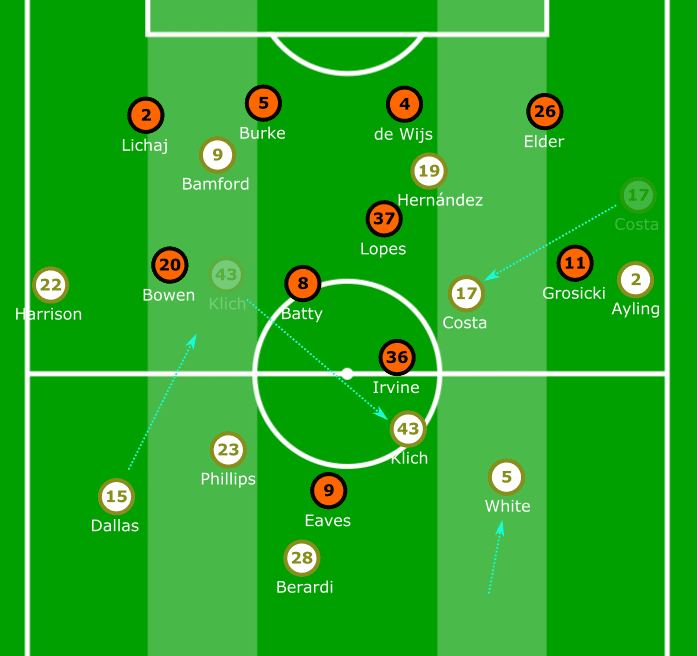
After substituting Harrison for Alioski, Leeds were able to strengthen their defence. Alioski did not offer the technical ability with his dribbling that Harrison does, but he was able to capitalise on his distribution and play the direct ball to Bamford, one of which came very close to increasing the tally for the hosts. Nevertheless, Alioski was able to find the back of the net from Bamford’s shot rebounding off the sidepost in a counter-attack and put Leeds 2-0 up giving Hull City little chance to recover after.
Ayling put up a captain’s performance
Leeds were severely missing their regular captain, Liam Cooper who has been sidelined again with injury. It was the right-back Ayling who stepped in to lead the whites at Elland Road. Ayling’s performance has to be commended for this win.
We looked at how Leeds were struggling to come out from the back using the central defenders. Phillips was also silenced during this game. It was Ayling who stepped in to fill the shortcomings and provide challenges for Hull City, leading by example. If we look at his heatmap, we see that apart from his usual right-back position, he drifted inside on multiple occasions both offensively and defensively when necessary to cover for his teammates. Ayling also had 103 touches in this game, the most number of touches for Leeds United.
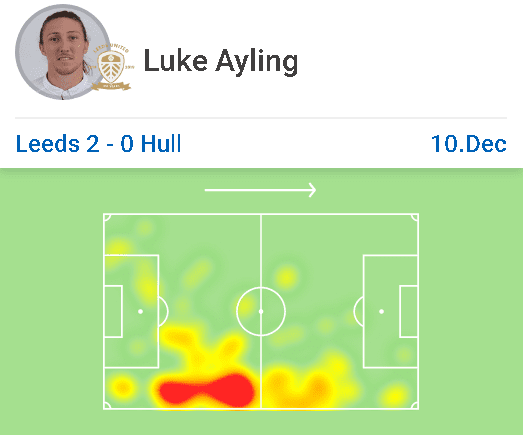
Ayling’s ability to make decisions when his side’s tactics are being effectively countered, and his display of excellent tactical sense to uphold Bielsa’s game principles and retain the momentum that Leeds are comfortable with makes him a very important leader of the team to see them defend their position at the top of the table.
Conclusion
Leeds’ win puts them level on points with West Brom after this midweek fixture. They face Cardiff City over the weekend and keeping up their positive performances after a period of struggle would be the priority. Bielsa was able to demonstrate great skill in adapting his tactics effectively in the second half when his side was hitting a wall. He will hope to continue pushing the Yorkshire side through tactically challenging games in order to push for the automatic promotion this season.
Hull City demonstrated great tenacity and strategy in their effort to contain Leeds. They played to their strengths and found many opportunities to punish the home side on their errors. It came down to luck and the physicality of Bielsa’s side that prevented the tigers from boasting a great result out of this game.

If you love tactical analysis, then you’ll love the digital magazines from totalfootballanalysis.com – a guaranteed 100+ pages of pure tactical analysis covering topics from the Premier League, Serie A, La Liga, Bundesliga and many, many more. Buy your copy of the December issue for just ₤4.99 here





Comments